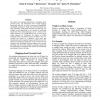AAAI
2004
14 years 1 months ago
2004
Simulation-based training is increasingly being used within the military to practice and develop the skills of successful soldiers. For the skills associated with successful milit...
NAACL
2007
14 years 1 months ago
2007
This paper explores the use of statistical machine translation (SMT) methods for tactical natural language generation. We present results on using phrase-based SMT for learning to...
NIPS
2008
14 years 1 months ago
2008
Language and image understanding are two major goals of artificial intelligence which can both be conceptually formulated in terms of parsing the input signal into a hierarchical ...
IJCAI
2007
14 years 1 months ago
2007
The research areas of plan recognition and natural language parsing share many common features and even algorithms. However, the dialog between these two disciplines has not been ...
LREC
2008
14 years 1 months ago
2008
Question Answering systems are systems that enable the user to ask questions in natural language and to also receive an answer in natural language. Most existing systems, however,...
LREC
2008
14 years 1 months ago
2008
In the context of Natural Language Processing, annotation is about recovering implicit information that is useful for natural language applications. In this paper we describe a &q...
ICWSM
2008
14 years 1 months ago
2008
We explore the emerging phenomenon of blogging about personal goals, and demonstrate how natural language processing tools can be used to uncover psychologically meaningful constr...
EJC
2008
14 years 1 months ago
2008
The notion of a fragment was coined by Montague 1974 to illustrate the formal handling of certain puzzles, such as de dicto/de re, in a truth-conditional semantics for natural lan...
LREC
2010
14 years 1 months ago
2010
Natural language understanding systems require a knowledge base provided with conceptual representations reflecting the structure of human beings' cognitive system. Although ...
LREC
2010
14 years 1 months ago
2010
In Natural Language Processing (NLP), the quality of a system depends to a great extent on the quality of the linguistic resources it uses. Due to the unpredictable character of v...







